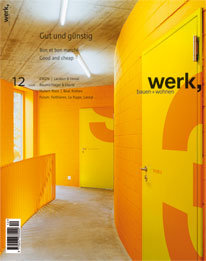Editorial
Editorial
In our magazine much is written about architectural quality, urban planning references, sophisticated details and exciting sequences of spaces. We are all aware that these qualities cannot be had for nothing and we know, too, how strongly the means available influence the result: the scope for design is far greater when everything does not have to be exploited down to the last square metre. Nevertheless, we mention building costs only peripherally, if at all, or present them, without comment, alongside each other in the form of sober rows of figures, like in werk material. Is this typically Swiss? Whether or not, it is true that in the documentary film Der Duft des Geldes (The Scent of Money), which was made by Dieter Gränicher and was shown in cinemas here in 1998, not all the persons portrayed wanted to be mentioned by name. In this issue we change for once the familiar form of our reports to put the spotlight on costs. Not because we want to break a taboo but out of interest in how good architecture can be built with little money. Naturally, what we are talking about here are exceptionally tight budgets, not the everyday need to employ financial resources (which are in any case always too limited to satisfy all wishes) economically, which is something that is also called for in the high-price sector. But when means are limited the questions about where they should flow, about what should be given priority and what can be dispensed with become all the more pressing. For this issue the authors, armed with questions like these, approached five architects' offices in Switzerland and nearby foreign countries that represent independent and explicit approaches to this theme: Baumschlager & Eberle, EM2N, Lacaton & Vassal, Hubert Riess, Beat Rothen. The outcome of the discussions? Where finances are limited or extremely restricted the critical examination of the currently applicable standards, conceptual work and strategic planning are extremely important. Therefore it is not primarily the effective size of the budge that is decisive - after all what is regarded as limited is relative, as the comparison between Swiss and foreign positions clearly shows - but that every franc or euro should be profitably invested: in architectural quality, above all in large and good spaces. The journalistic form we chose for all contributions was the conversation. As Otto Kapfinger, who talked to Hubert Riess, rightly remarked, this form in itself represents a certain contrast to the theme dealt with, for the game of question and answer needs more space and does not allow itself to be compressed in terms of language and content to the same extent as a „normal“ text. Be that as it may: the interview or conversation allows the explosiveness of the theme, the diversity of the possible contexts and, not least importantly, the emotions that are awoken to be expressed in a very direct way, without digression.
The editors
